Scar Revision

- Scars are the skin’s biological healing process of wound repair. It can occur from an injury, disease, surgery or even acne.
- Scars are very common and stubborn problem to remove. They are discoloured and are shiny and smooth with no hair follicles and sweat glands.
- Scar revision is a cosmetic treatment that considerably reduces the appearance of scars. Various treatments can be used in combination to achieve optimum results. However, it is to be noted that scars cannot be 100% reversed.
Keloid Scar
These are thick, rounded, irregular clusters of scar tissue that grow at the site of a wound on the skin, but beyond the edges of the borders of the wound. They often appear red or darker in color, as compared to the surrounding normal skin.
Keloids are formed from skin cells and connective tissue cells (fibroblasts) that are multiplying to repair the damage. These scars may appear anywhere on the body, but more commonly on the face, neck, ears, chest, or shoulders. They occur more often in darker-skinned people. Keloid scars may occur up to one year after the original trauma to the skin.
There is no one simple cure for keloid scar removal. Recurrence after treatment is common.
Treatment option may include
1. Steroid injections– are injected directly into the keloid scar tissue to decrease the itching, redness, and burning sensations that these scars may produce. Sometimes, the injections help to actually decrease the size of the scar.
2. Cryotherapy– involves the scar being “frozen” off by a medication. This treatment is often effective in conjunction with steroid injections for keloid scars.
3. Pressure therapy– involves a type of pressure appliance worn over the area of the keloid scar. These may be worn day and night for up to 4 to 6 months.
4. Surgery–If the keloid scar is not responsive to nonsurgical management options, surgery may be done.
5. Radiation therapy– -it is often used in conjunction with surgery to decrease the risk of recurrence of a keloid scar.
Hypertrophic Scars
Hypertrophic scars are similar to keloid scars.However their growth is confined within the boundaries of the original skin defect. These scars may also appear red, and are usually thick and elevated. Hypertrophic scars usually start to develop within weeks after the injury to the skin. Hypertrophic scars may improve naturally, although this process may take up to a year or more.
Treatment
1. Steroid is first line of therapy. Steroids may be given as an injection or by direct application. These scars may also be removed surgically. Often, steroid injections are used along with the surgery and may continue up to 2 years after the surgery to help maximize healing and decrease the chance of the scar returning.
2. Surgical treatment-scar revision surgery
Scar revision surgery and non-surgical treatments may be done alone or in combination. Procedures vary depending on the type of scar.
- Skin grafts, and skin flaps
- Z-plasty
- Surgical excision
Result

